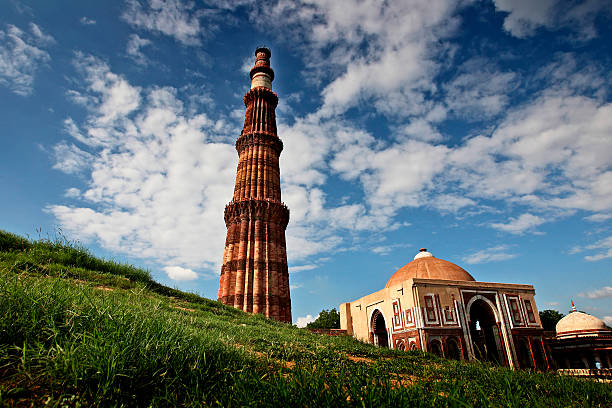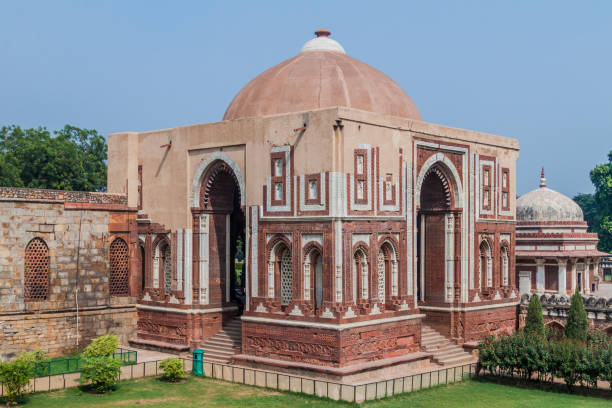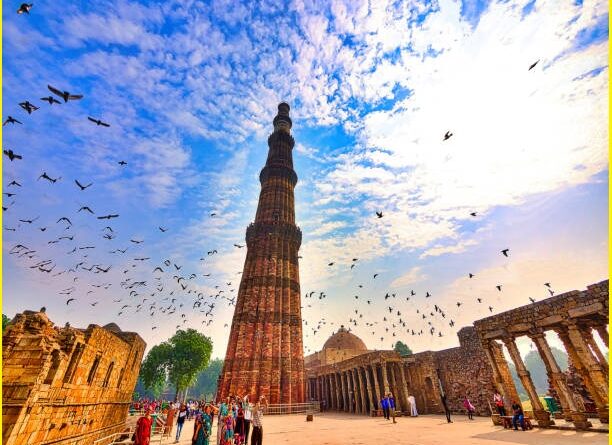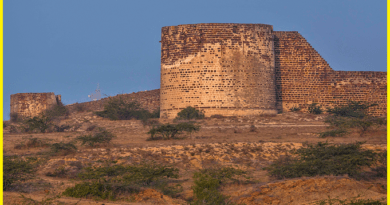Qutub Minar-The Majestic Marvel and Delhi’s Iconic Landmark
Qutub Minar
Qutub Minar is a famous historical monument located in Mehrauli, Delhi, India. It is one of the most iconic landmarks in the city and attracts a large number of tourists from around the world. Qutub Minar was built in the 12th century by Qutub-ud-din Aibak, the founder of the Delhi Sultanate.
The construction of the minaret was started in 1192 and completed in 1220 by his successor, Iltutmish. It was originally built as a victory tower to celebrate Muslim dominance in Delhi. Qutub Minar, along with its surrounding monuments, was declared a UNESCO World Heritage Site in 1993. It is recognized for its historical and architectural significance and serves as a testament to the rich cultural heritage of Delhi.
Qutub Minar history
Qutub Minar’s history dates back to the 12th century when it was built during the reign of the Delhi Sultanate. The Qutub Minar is the tallest brick minaret in the world and is surrounded by several other historical structures. The complex also includes the Quwwat-ul-Islam Mosque, which was built by Qutub-ud-din Aibak and is one of the oldest mosques in India. The Iron Pillar or Vishnu stambh, a 7-meter iron column dating back to the 4th century, is also located in the complex.

Construction of Qutub Minar- The construction of Qutub Minar Delhi was initiated by Qutub-ud-din Aibak, the first ruler of the Delhi Sultanate. Aibak started building the minaret in 1192 after defeating the last Hindu ruler in Delhi. The purpose of its construction was to celebrate the victory and mark the beginning of Muslim rule in the region.
Qutub-ud-din Aibak’s successor, Iltutmish, completed the construction of the minaret in 1220. He added three more stories to the original structure built by Aibak. The additional stories were made of red sandstone, and the whole minaret was adorned with intricate carvings and inscriptions.
Also, read- Agra Fort-A Magnificent Mughal Stronghold of Architectural Splendor
Design- It is believed that the design and architectural style of the Qutb Minar Delhi was inspired by the Minaret of Jam in Afghanistan. The Afghan influence can be seen in the design elements and the construction technique of the minaret. The Qutub Minar Delhi is designed in a distinct Afghan architectural style, influenced by Persian and Islamic elements. The lower three stories are intricately carved with decorative motifs, including verses from the Quran. The minaret tapers towards the top, and the uppermost story features a conical dome.
Architecture- The Qutb Minar Delhi is an example of Indo-Islamic architecture and is made of red sandstone and marble. The minaret is 73 meters tall and has five distinct stories, each marked by a projecting balcony. The first three stories are built with red sandstone, while the fourth and fifth stories are made of marble and sandstone.

Historical Significance- Besides being a victory tower, Qutub Minar has witnessed various historical events. It was used for calling the faithful to prayer during the time of Islamic rule. The complex surrounding the minaret also includes several other significant structures, such as the Quwwat-ul-Islam Mosque and the Iron Pillar, which add to its historical importance.
Over the centuries, Qutb Minar has faced damage due to earthquakes and other natural disasters. The most significant damage occurred in 1803 when the top two stories were damaged by an earthquake.
Qutub complex
The Qutub Complex is a historical site centered around the famous Qutub Minar. It is a UNESCO World Heritage Site and contains several other notable structures that collectively form a significant historical and architectural complex.
The Qutub Minar is the main attraction and centerpiece of the complex. The minaret is intricately carved and features five distinct stories, each adorned with ornamental balconies.
The Quwwat-ul-Islam Mosque, meaning “Might of Islam,” is one of the oldest mosques in India and is situated within the Qutub Complex. It was constructed by Qutub-ud-din Aibak, the founder of the Delhi Sultanate, in the late 12th century. The mosque incorporates elements of Hindu and Jain temples, as many of its materials were obtained from demolishing 27 Hindu and Jain temples.
The Alai Darwaza is an impressive gateway that was added to the Qutub Complex by Sultan Ala-ud-din Khalji in the 14th century. It is built with red sandstone and showcases intricate carvings and calligraphy. The Alai Darwaza once served as the entrance to the Quwwat-ul-Islam Mosque and is known for its striking architectural style.

The Iron Pillar is another remarkable structure within the complex. It is a 7-meter tall iron column believed to date back to the 4th century. The column is notable for its exceptional corrosion resistance, as it has withstood the elements for centuries without significant rusting or deterioration. The Iron Pillar bears inscriptions in Sanskrit, praising the achievements of King Chandragupta II.
The Tomb of Iltutmish is the mausoleum of Sultan Iltutmish, who completed the construction of the Qutub Minar Delhi. It is a square chamber with a flat roof and is built of red sandstone. The tomb exhibits fine architectural details, including intricate geometrical patterns and calligraphic inscriptions.
The “Vishnu Stambh” is a notable Iron Pillar of Delhi, which is located within the Qutub Complex. It is often associated with Lord Vishnu due to the inscriptions on the pillar, which mention a ruler named Chandra, believed to be King Chandragupta II of the Gupta Empire, who dedicated the pillar to Lord Vishnu.
Qutub Minar timing
The timings for visiting Qutub Minar Delhi, India, are as follows-
- Opening Hours: Qutb Minar is generally open to visitors every day of the week, including weekends and public holidays.
- Morning Timing: The complex usually opens early in the morning, around 6:00 or 7:00 AM.
- Closing Hours: The closing time for visitors at Qutub Minar is typically in the evening, around 5:00 or 6:00 PM.
Please note that the exact opening and closing times may vary, so it is advisable to check the official website or contact the authorities for the most up-to-date information regarding visiting hours.
As of cutoff in September 2021, the entry fee for visiting Qutub Minar Delhi, India, is as follows-
- For Indian Citizens-
- Adults: ₹30 per person
- Children (15 years and below): Free
- For Foreign Nationals-
- Adults: ₹500 per person
- Children (15 years and below): ₹250 per person
Please note that these entry fees are subject to change, and it is advisable to check the official website or contact the authorities for the most up-to-date information on entry fees before planning your visit.
As of cutoff in September 2021, Qutub Minar Delhi, India, does not have a specific closing day. It is generally open to visitors throughout the week, including weekends and public holidays. However, please note that there may be certain exceptions or temporary closures for maintenance or other reasons.

To get the most accurate and up-to-date information on the closing days or any temporary closures of Qutub Minar Delhi, I recommend checking the official website of the Archaeological Survey of India (ASI) or contacting their local office or the Qutub Minar complex directly.
How to Reach Qutub Minar Delhi
Qutub Minar is located in Mehrauli, a neighborhood in South Delhi, India. The nearest metro station to Qutub Minar is “Qutub Minar” on the Yellow Line. After reaching the metro station, you can take an auto-rickshaw or walk to the monument, which is around 1.5 kilometers away.
Delhi Transport Corporation (DTC) buses operate throughout the city, including routes that pass near Qutub Minar. You can check the local bus schedules and routes to find the most convenient option. Taxis and ride-sharing services like Uber and Ola are widely available in Delhi. You can book a taxi or use a ride-sharing app to reach Qutub Minar Delhi directly.



